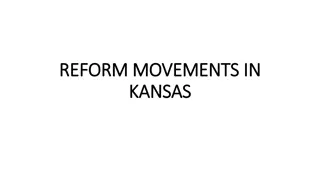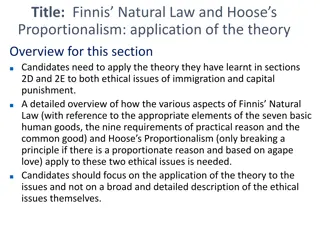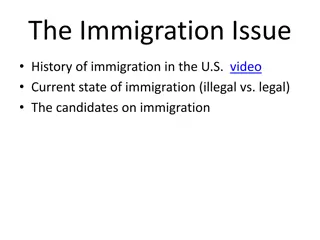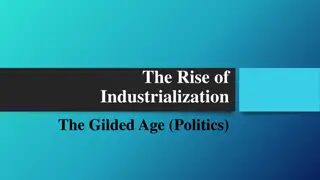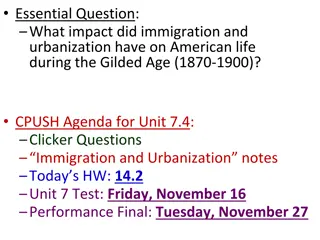The Rise of Immigration in America During the Gilded Age
Immigration played a crucial role in American history during the Gilded Age, with the foreign-born population doubling between 1870 and 1900. The influx of new immigrants from southern and eastern Europe brought about significant cultural and social changes, leading to tensions and fears among native-born Americans. Push and pull factors, such as economic opportunities and religious freedom, influenced the immigration patterns. Despite challenges, immigrants contributed to the growth and diversity of American society during this era.
Download Presentation

Please find below an Image/Link to download the presentation.
The content on the website is provided AS IS for your information and personal use only. It may not be sold, licensed, or shared on other websites without obtaining consent from the author.If you encounter any issues during the download, it is possible that the publisher has removed the file from their server.
You are allowed to download the files provided on this website for personal or commercial use, subject to the condition that they are used lawfully. All files are the property of their respective owners.
The content on the website is provided AS IS for your information and personal use only. It may not be sold, licensed, or shared on other websites without obtaining consent from the author.
E N D
Presentation Transcript
The Rise of Industrialization The Gilded Age (Immigration)
New Immigrants Immigration is a central theme of American history Foreign born population of US doubled between 1870 and 1900 Fear among Americans that that immigrants would destroy American culture
Old Immigrants Until 1870, most immigrants that came to the US were Protestants from northern and western Europe Many had saved money, had a skill or trade, and were educated Many were German and Irish Catholics Though some Americans were prejudiced to Catholics, the Irish spoke English and German Catholics benefited from good reputation of their Protestant countrymen
New Immigrants Beginning in 1870, new immigrants from southern and eastern Europe began coming to America Often unskilled, poor, Catholic or Jewish, usually settled in cities Came from Italy, Greece, Poland, Hungary, and Russia Planned to make money and return home to Europe Many native-born Americans felt threatened by newcomers with different cultures and languages
Push/Pull Factors Push/Pull Factors are factors that lead to people immigrating Push Factors- factors that compel people to leave their homes Famine, war, persecution Pull Factors- factors that draw people to a new place Economic opportunity, religious freedom
Push Factors Land reform and low prices forced many in Mexico, Poland, and China to move off of farms and come to the US Wars and political revolutions forced many from China and eastern Europe to immigrate Russian and eastern European Jews came to the US to escape religious persecution
Pull Factors US offered opportunity for plentiful land and employment Homestead Act attracted those looking for land Railroad construction and other jobs attracted many foreign workers US offered political and religious freedom to immigrants
Arriving in America First stop for ships bringing immigrants to America was at a processing station Immigration officials decided who could stay in US Beginning in 1892, immigrants from Europe arriving in New York went through Ellis Island
Ellis Island Third-class passengers on ships sent to Ellis Island Immigration officials did legal and medical inspections Checked to ensure they were healthy, had money, a skill, or a sponsor Only about 2 percent denied entry due to shipowners doing preliminary screening prior to boarding
Angel Island Chinese and other Asian immigrants were processed at Angel Island, which opened in 1910 Was always formidable and seemed designed to filter out Chinese immigrants
Chinese Exclusion Act Signed into law in 1882 by Chester A. Arthur Suspended Chinese immigration for ten years and made it impossible for Chinese to become naturalized citizens Though it was challenged by Chinese already in America, their efforts failed Extended another ten years in 1892, then Chinese immigration made permanently illegal in 1902
Life in America Most immigrants settled in cities close to factories Often lived in ethnic neighborhoods with people who shared their native language, religion, and culture
Nativism Newcomers to the US often faced nativism (the belief that native-born white Americans were superior to immigrants) Competition for jobs and housing fueled resentment Immigrants willing to work for less wages Religious differences sparked suspicion between native-born workers and immigrants
Nativism Religion was a big problem Protestants were suspicious of Catholicism: Irish, German, Italian, and Polish Many native-born Protestants would not hire Catholics or Jews Some Americans signed agreements not to rent or sell property to Catholics, Jews, African Americans, or other groups they considered non-native













